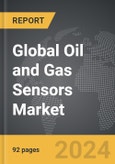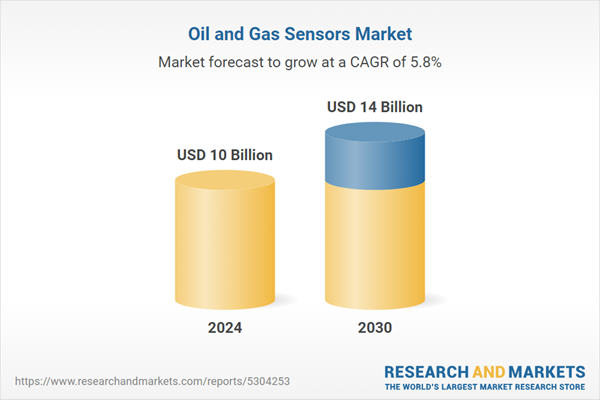The global market for Oil and Gas Sensors was valued at US$10.0 Billion in 2024 and is projected to reach US$14.0 Billion by 2030, growing at a CAGR of 5.8% from 2024 to 2030. This comprehensive report provides an in-depth analysis of market trends, drivers, and forecasts, helping you make informed business decisions. The report includes the most recent global tariff developments and how they impact the Oil and Gas Sensors market.
Segments: Type (Pressure Sensor, Temperature Sensor, Level Sensor, Flow Sensor, Other Types); Connectivity (Wired, Wireless); Application (Downstream, Midstream, Upstream).
Geographic Regions/Countries: World; United States; Canada; Japan; China; Europe (France; Germany; Italy; United Kingdom; Spain; Russia; and Rest of Europe); Asia-Pacific (Australia; India; South Korea; and Rest of Asia-Pacific); Latin America (Argentina; Brazil; Mexico; and Rest of Latin America); Middle East (Iran; Israel; Saudi Arabia; United Arab Emirates; and Rest of Middle East); and Africa.
The analysts continuously track trade developments worldwide, drawing insights from leading global economists and over 200 industry and policy institutions, including think tanks, trade organizations, and national economic advisory bodies. This intelligence is integrated into forecasting models to provide timely, data-driven analysis of emerging risks and opportunities.
Global Oil and Gas Sensors Market - Key Trends and Drivers Summarized
Why Are Oil and Gas Sensors Critical for Operational Safety and Efficiency?
Oil and gas sensors play a crucial role in monitoring, control, and safety across the entire hydrocarbon value chain, providing real-time data on pressure, temperature, flow, gas detection, and equipment condition. These sensors are used in upstream, midstream, and downstream operations, helping to ensure operational efficiency, prevent leaks, and maintain safety standards. As the industry faces increasing challenges related to environmental compliance, cost efficiency, and safety, oil and gas sensors have become vital tools for data-driven decision-making, predictive maintenance, and process optimization. With advancements in sensor technologies, including wireless communication and IoT integration, sensors are becoming more accurate, durable, and adaptable to harsh conditions.What Are the Key Segments in the Oil and Gas Sensors Market?
Major sensor types include pressure sensors, temperature sensors, flow sensors, gas sensors, and level sensors, with pressure sensors being the most widely used due to their importance in maintaining pressure control in drilling, transportation, and refining. In terms of application, sensors are used for drilling and exploration, pipeline monitoring, refining processes, and safety and leak detection systems. End-use sectors encompass upstream, midstream, and downstream operations, with upstream activities representing the largest market segment due to the need for continuous monitoring of well conditions and production equipment.How Are Oil and Gas Sensors Being Used Across Different Operations?
In upstream operations, sensors are used for well monitoring, measuring pressure, temperature, and flow rates to optimize drilling, completion, and production activities. They are also used in blowout preventers and drilling mud systems to maintain well control and prevent equipment failure. In midstream operations, sensors monitor pipeline pressure, temperature, and flow to detect leaks, ensure pipeline integrity, and maintain safe transportation of hydrocarbons. In downstream operations, sensors are integrated into refining processes to monitor reaction conditions, control temperatures in distillation columns, and detect gas leaks, ensuring operational safety and efficiency. Additionally, gas sensors play a vital role in detecting hazardous gases like methane and hydrogen sulfide, protecting workers and the environment from potential risks.What Factors Are Driving the Growth in the Oil and Gas Sensors Market?
The growth in the Oil and Gas Sensors market is driven by several factors, including the increasing need for real-time monitoring and automation in oil and gas operations, which enhances safety and operational efficiency. The expansion of digital oilfield technologies, which rely heavily on IoT-enabled sensors for data collection and analysis, has fueled sensor demand across the sector. The growing focus on safety and environmental compliance has further accelerated the adoption of gas detection and leak monitoring sensors, especially in offshore and pipeline operations. Advancements in sensor technology, including wireless connectivity, increased durability, and improved accuracy, have supported broader deployment in harsh and remote environments. Additionally, the need for predictive maintenance solutions, which rely on sensors for early detection of equipment failure, is contributing to the growth of the oil and gas sensors market.Report Scope
The report analyzes the Oil and Gas Sensors market, presented in terms of units. The analysis covers the key segments and geographic regions outlined below.Segments: Type (Pressure Sensor, Temperature Sensor, Level Sensor, Flow Sensor, Other Types); Connectivity (Wired, Wireless); Application (Downstream, Midstream, Upstream).
Geographic Regions/Countries: World; United States; Canada; Japan; China; Europe (France; Germany; Italy; United Kingdom; Spain; Russia; and Rest of Europe); Asia-Pacific (Australia; India; South Korea; and Rest of Asia-Pacific); Latin America (Argentina; Brazil; Mexico; and Rest of Latin America); Middle East (Iran; Israel; Saudi Arabia; United Arab Emirates; and Rest of Middle East); and Africa.
Key Insights:
- Market Growth: Understand the significant growth trajectory of the Pressure Sensor segment, which is expected to reach US$5.3 Billion by 2030 with a CAGR of a 7.5%. The Temperature Sensor segment is also set to grow at 5.5% CAGR over the analysis period.
- Regional Analysis: Gain insights into the U.S. market, valued at $2.6 Billion in 2024, and China, forecasted to grow at an impressive 9.4% CAGR to reach $3.4 Billion by 2030. Discover growth trends in other key regions, including Japan, Canada, Germany, and the Asia-Pacific.
Why You Should Buy This Report:
- Detailed Market Analysis: Access a thorough analysis of the Global Oil and Gas Sensors Market, covering all major geographic regions and market segments.
- Competitive Insights: Get an overview of the competitive landscape, including the market presence of major players across different geographies.
- Future Trends and Drivers: Understand the key trends and drivers shaping the future of the Global Oil and Gas Sensors Market.
- Actionable Insights: Benefit from actionable insights that can help you identify new revenue opportunities and make strategic business decisions.
Key Questions Answered:
- How is the Global Oil and Gas Sensors Market expected to evolve by 2030?
- What are the main drivers and restraints affecting the market?
- Which market segments will grow the most over the forecast period?
- How will market shares for different regions and segments change by 2030?
- Who are the leading players in the market, and what are their prospects?
Report Features:
- Comprehensive Market Data: Independent analysis of annual sales and market forecasts in US$ Million from 2024 to 2030.
- In-Depth Regional Analysis: Detailed insights into key markets, including the U.S., China, Japan, Canada, Europe, Asia-Pacific, Latin America, Middle East, and Africa.
- Company Profiles: Coverage of players such as ABB Ltd, BD Sensors Gmbh, Emerson Electric Co., Fortive, General Electric Company and more.
- Complimentary Updates: Receive free report updates for one year to keep you informed of the latest market developments.
Some of the 36 companies featured in this Oil and Gas Sensors market report include:
- ABB Ltd
- BD Sensors Gmbh
- Emerson Electric Co.
- Fortive
- General Electric Company
- Honeywell
- Indutrade AB
- LORD Corporation
- MTS Sensors Technology Corp.
- Robert Bosch GmbH
- Rockwell Automation, Inc.
- TE Connectivity Ltd.
Tariff Impact Analysis: Key Insights for 2025
Global tariff negotiations across 180+ countries are reshaping supply chains, costs, and competitiveness. This report reflects the latest developments as of April 2025 and incorporates forward-looking insights into the market outlook.The analysts continuously track trade developments worldwide, drawing insights from leading global economists and over 200 industry and policy institutions, including think tanks, trade organizations, and national economic advisory bodies. This intelligence is integrated into forecasting models to provide timely, data-driven analysis of emerging risks and opportunities.
What’s Included in This Edition:
- Tariff-adjusted market forecasts by region and segment
- Analysis of cost and supply chain implications by sourcing and trade exposure
- Strategic insights into geographic shifts
Buyers receive a free July 2025 update with:
- Finalized tariff impacts and new trade agreement effects
- Updated projections reflecting global sourcing and cost shifts
- Expanded country-specific coverage across the industry
Table of Contents
I. METHODOLOGYII. EXECUTIVE SUMMARY2. FOCUS ON SELECT PLAYERSIII. MARKET ANALYSISCANADAITALYSPAINRUSSIAREST OF EUROPESOUTH KOREAREST OF ASIA-PACIFICARGENTINABRAZILMEXICOREST OF LATIN AMERICAIRANISRAELSAUDI ARABIAUNITED ARAB EMIRATESREST OF MIDDLE EASTIV. COMPETITION
1. MARKET OVERVIEW
3. MARKET TRENDS & DRIVERS
4. GLOBAL MARKET PERSPECTIVE
UNITED STATES
JAPAN
CHINA
EUROPE
FRANCE
GERMANY
UNITED KINGDOM
ASIA-PACIFIC
AUSTRALIA
INDIA
LATIN AMERICA
MIDDLE EAST
AFRICA
Companies Mentioned (Partial List)
A selection of companies mentioned in this report includes, but is not limited to:
- ABB Ltd
- BD Sensors Gmbh
- Emerson Electric Co.
- Fortive
- General Electric Company
- Honeywell
- Indutrade AB
- LORD Corporation
- MTS Sensors Technology Corp.
- Robert Bosch GmbH
- Rockwell Automation, Inc.
- TE Connectivity Ltd.
Table Information
| Report Attribute | Details |
|---|---|
| No. of Pages | 92 |
| Published | April 2025 |
| Forecast Period | 2024 - 2030 |
| Estimated Market Value ( USD | $ 10 Billion |
| Forecasted Market Value ( USD | $ 14 Billion |
| Compound Annual Growth Rate | 5.8% |
| Regions Covered | Global |









